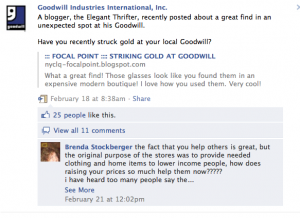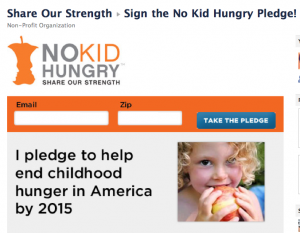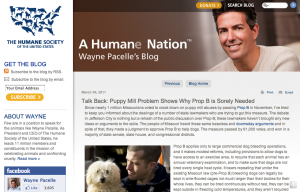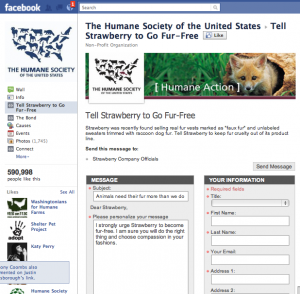 Social media case studies. There’s a ton of them online (here’s one of the better case study aggregation posts, FYI). We hear an awful lot about case studies like Southwest Airlines, Dell and Comcast. Come to think of it, most of the case studies we hear about are retail or consumer-based in nature, aren’t they?
Social media case studies. There’s a ton of them online (here’s one of the better case study aggregation posts, FYI). We hear an awful lot about case studies like Southwest Airlines, Dell and Comcast. Come to think of it, most of the case studies we hear about are retail or consumer-based in nature, aren’t they?
And that’s fine. Those are the companies that are typically ahead of the curve and have the resources to try new things and experiment a bit.
But, what about non-profits? We don’t hear as much about those kinds of organizations in terms of case studies.
Why not?
They typically don’t have the resources or budget to pull of some of the more interesting campaigns case studies are designed around. They typically don’t employ the social media celebrity types that garner the type of case study merit. And, they typically don’t have high-powered agencies and consultants pushing their story and applying for industry awards (where case studies are often discovered).
But, despite those factors, there are a number of non-profit case studies out there. In recent years, Charity Water and Danny Brown’s 12for12K are two that come to mind immediately. Both did some very interesting things when it came to using social media tools to achieve their goals.
But what about today? What organizations are setting the bar high in 2011 when it comes to non-profits using social media the right way? And which non-profits are taking a more pragmatic approach? One that’s delivering results while not breaking their cash-strapped bank?
A few I’ve found interesting over the last few months:
Goodwill
What are they doing well?
* Twitter lists. I’ve long felt Twitter lists are an under-utilized resource by brands. But, for non-profits they’re a wonderful opportunity to recognize key partners and volunteers and monitor bloggers and other advocates. Goodwill has lists for partners, “thrifty” bloggers and green news outlets. By organizing their Twitter followers by list, it gives them a great way to scan and track activity on Twitter from day-to-day and recognize, highlight and share, when appropriate.
 * Recognizing the community around them. Goodwill does a nice job of scanning for those bloggers, organizations and people who might be talking about them or promoting them and highlighting that work. Here’s just one example from their Facebook page. Why is this important? For non-profits, their volunteer and supporters are their lifeblood. By recognizing them publicly (remember, Goodwill has 23,000+ Facebook fans, so a post on their site is significant), they are in fact saying, we value you and your hard work. That makes a difference for volunteers and supporters, believe me. And, it engenders (excuse the pun) more goodwill. As a result, the chances that these people will either donate again, volunteer more time or share with friends is increased.
* Recognizing the community around them. Goodwill does a nice job of scanning for those bloggers, organizations and people who might be talking about them or promoting them and highlighting that work. Here’s just one example from their Facebook page. Why is this important? For non-profits, their volunteer and supporters are their lifeblood. By recognizing them publicly (remember, Goodwill has 23,000+ Facebook fans, so a post on their site is significant), they are in fact saying, we value you and your hard work. That makes a difference for volunteers and supporters, believe me. And, it engenders (excuse the pun) more goodwill. As a result, the chances that these people will either donate again, volunteer more time or share with friends is increased.
 * Success stories podcasts. Love what Goodwill is doing here. Sure, podcasts aren’t exactly the hottest of social media tools, but they can be effective. And, they put a very human face to the organization. More importantly, these podcasts allow those thinking of working for Goodwill the opportunity to get a glimpse into the kind of people working there, the types of jobs available and why people enjoy spending their time working for the organization. It’s a multi-media recruiting tool for Goodwill. A shareable, human, searchable multi-media recruiting tool.
* Success stories podcasts. Love what Goodwill is doing here. Sure, podcasts aren’t exactly the hottest of social media tools, but they can be effective. And, they put a very human face to the organization. More importantly, these podcasts allow those thinking of working for Goodwill the opportunity to get a glimpse into the kind of people working there, the types of jobs available and why people enjoy spending their time working for the organization. It’s a multi-media recruiting tool for Goodwill. A shareable, human, searchable multi-media recruiting tool.
Share Our Strength
What they’re doing well
* Using blog technology as a CMS. A move I suggest to many non-profit clients because of its ease of use and flexibility. Granted, I’m not positive Share our Strength is taking this approach, but their current site looks an awful lot like a WordPress template to me. And, that template gives them everything they’d need in Web site functionality. Sure, they probably needed a developer’s assistance in setting it up, but I guarantee you it didn’t come with the price tag the same Web site would have if completed by an outside vendor.
 * The No Kid Hungry Pledge. Check out Share our Strength’s Facebook page. Their custom welcome page is simple, but brilliant. On it, they ask you to take a pledge–help them end childhood hunger by 2015. Once you sign up, you receive a short email message simply asking you to help spread the word by way of social status updates (templated Facebook and Twitter posts) or via email. No ask for money. No ask to volunteer your time. Just spread the word. And, they’re building a valuable email database of super-fans that they can stay connected with through your email inbox.
* The No Kid Hungry Pledge. Check out Share our Strength’s Facebook page. Their custom welcome page is simple, but brilliant. On it, they ask you to take a pledge–help them end childhood hunger by 2015. Once you sign up, you receive a short email message simply asking you to help spread the word by way of social status updates (templated Facebook and Twitter posts) or via email. No ask for money. No ask to volunteer your time. Just spread the word. And, they’re building a valuable email database of super-fans that they can stay connected with through your email inbox.
* The basics of blogging. SOS doesn’t do anything sexy with their blog–but the basics can be powerful over time. They blog about topics important to their audience (advocacy, how their partners are supporting SOS and specific programs like Cooking Matters). They include multiple bloggers from across the organization (easing the blogging burden). And, they make it easy to subscribe via email (which is how most people will subscribe vs. RSS). You won’t find a ton of comments on their blog, but that doesn’t necessarily mean it’s a failure. Remember, each of these posts is now an “informational annuity” (term I’m stealing from Jay Baer and Amber Naslund). It’s searchable. And, it’s easy to share with partners, volunteers and potential donors with a simple click of the mouse.
The Humane Society of the United States
What they are doing well
* Focus. Visit any non-profit home page these days and you’ll likely see a variety of social media interaction. Organizations with Facebook and Twitter pages, YouTube channels and even FlickR accounts. Wait, I thought these organizations were strapped for resources? How are they keeping on top of all these real-time platforms? Turns out, many aren’t. They’re creating them–then either letting them wilt or adding meaningless content noise. The Humane Society hasn’t taken that route. They’re saying simply that blogging, Twitter and Facebook are where they’re going to concentrate their efforts. Now, that’s a ton of work, especially when your Facebook posts get 500-plus comments! But, it’s a much better approach than the spray-and-pray approach.
 * Telling their story through the “top dog.” Sorry, I just couldn’t resist the obvious pun 😉 You gotta give the Humane Society–and Wayne Pucelle–a lot of credit. You can count the number of CEOs who blog in this country (heck, across the world) on your hands and toes. OK, so that’s an exaggeration, but you get the point. It’s an exclusive club. It gets to be an even tighter group when you talk about CEOs that have been blogging since 2007. But, that’s only part of the story here. What really impresses me about The Humane Society is their knack for nailing the basics of blogging. Consistency? Wayne posts virtually every week day (and again, going back to 2007). Community building? Each post includes numerous links to relevant and helpful resources and sites. Is it easy to share and subscribe to? Email subscribe button right at the top and easy share buttons at the bottom of each post (many with more than 200 “Likes”). Want to know more about Wayne? Yep, that’s right at the top, too. After reading a post, what if I want to donate to The Humane Society? One click right at the top of each post and we can take care of that. My point? The Humane Society doesn’t do anything sexy with Wayne’s blog–but it’s a damn effective storytelling device for the organization because they execute the basics so well. Time and time again.
* Telling their story through the “top dog.” Sorry, I just couldn’t resist the obvious pun 😉 You gotta give the Humane Society–and Wayne Pucelle–a lot of credit. You can count the number of CEOs who blog in this country (heck, across the world) on your hands and toes. OK, so that’s an exaggeration, but you get the point. It’s an exclusive club. It gets to be an even tighter group when you talk about CEOs that have been blogging since 2007. But, that’s only part of the story here. What really impresses me about The Humane Society is their knack for nailing the basics of blogging. Consistency? Wayne posts virtually every week day (and again, going back to 2007). Community building? Each post includes numerous links to relevant and helpful resources and sites. Is it easy to share and subscribe to? Email subscribe button right at the top and easy share buttons at the bottom of each post (many with more than 200 “Likes”). Want to know more about Wayne? Yep, that’s right at the top, too. After reading a post, what if I want to donate to The Humane Society? One click right at the top of each post and we can take care of that. My point? The Humane Society doesn’t do anything sexy with Wayne’s blog–but it’s a damn effective storytelling device for the organization because they execute the basics so well. Time and time again.
 * Galvanizing its fans. Love what The Humane Society is going on their Facebook page with its “Tell Strawberry to go Fur-Free” campaign. They’ve set up a tab devoted to this campaign where they ask for supporters’ help. It’s easy. It’s simple. And it wouldn’t take a Humane Society supporter more than 2 minutes to complete. What’s beautiful about this is they’re taking a fan base they know already supports their organization and just giving them a simple tool to help them advocate for a cause they care about. The ask isn’t much (personal information). They’ve even inserted the start to a personal note for supporters to send. Plus, by asking for personal information, they’re also opening up the door to building a more personal relationship with these folks by opting-in for more email communications from the Humane Society.
* Galvanizing its fans. Love what The Humane Society is going on their Facebook page with its “Tell Strawberry to go Fur-Free” campaign. They’ve set up a tab devoted to this campaign where they ask for supporters’ help. It’s easy. It’s simple. And it wouldn’t take a Humane Society supporter more than 2 minutes to complete. What’s beautiful about this is they’re taking a fan base they know already supports their organization and just giving them a simple tool to help them advocate for a cause they care about. The ask isn’t much (personal information). They’ve even inserted the start to a personal note for supporters to send. Plus, by asking for personal information, they’re also opening up the door to building a more personal relationship with these folks by opting-in for more email communications from the Humane Society.

0 Comments